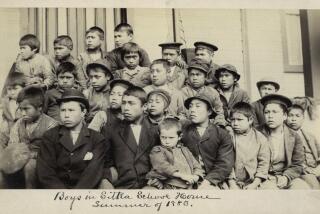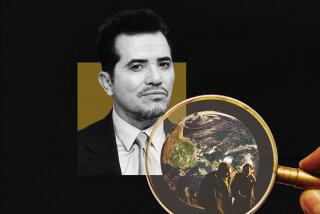What History Forgot : ‘SURVIVING COLUMBUS’ TELLS THE STORY OF PUEBLO INDIANS THROUGH THEIR OWN VOICES
As a youngster growing up in his native New Mexico, Acoma Pueblo Indian Conroy Chino learned very little at school about the history of his people.
“I went to a mission school,” said Chino, a one-time investigative reporter for KCOP who now works for an Albuquerque TV station.
“There were mostly non-Indians there and a handful of Acoma kids. You talk about the extremes of education; everything was basically taught from a non-Indian perspective. I don’t remember ever being taught anything about contemporary Indians. It is as if we were left on the pages of history books.”
The same thing has happened with the Christopher Columbus quincentennial. Indians--they prefer that description to Native Americans--say their perspective has been virtually ignored in the numerous documentaries, movies and specials focusing on Columbus’ “discovery” of America.
Three years ago, Larry Walsh, a visiting scholar at the University of New Mexico’s Latin American Institute, decided the original inhabitants of the United States should be given the chance to tell their own story.
“The whole Columbus quincentennial has been billed as the encounter between two cultures, but in looking at all the various other projects, there wasn’t a project presenting the other side of the story,” Walsh said. “We needed to get something that gave the other side of the story, not just celebrating Columbus, but looking at the impact on native peoples from their own perspective and their own voices, not just the white man’s viewpoint.”
“Surviving Columbus: The Story of the Pueblo People,” airing Monday on PBS, follows the 450 year-relationship of the Pueblos and other cultures, beginning with the Spanish explorers in 1539.
The program also explores their lives under the Spanish colonial period of the 18th Century, after Mexico’s independence from Spain in the early 19th Century and then under the U.S. government. Today there are 45,000 Pueblos in New Mexico, in addition to 25,000 in the Hopi region of Arizona and in Texas.
The two-hour documentary includes stories from elders, interviews with scholars and leaders, archival photographs, historical accounts and re-enactments.
Chino, who hosts the documentary, said “Surviving Columbus” not only illustrates the Pueblos’ journey through history, it also became a personal journey for him. “I think what stood out most in putting together this documentary was to hear all the Pueblo voices, young and old, and the range of feeling and emotion about the historical encounter between the Pueblos and the Spaniards,” he said. “Emotions (ranged) from anger to anguish to, just more recently among the young, feeling such hope.”
Director Diane Reyna, a Taos Pueblo, said she hopes “Surviving Columbus” will spur viewers to take an interest in Indian tribes who live near them. “A lot of tribes have gone through this type of history,” she said. “I hope it does educate (non-Indians) at least to see and allow another perspective on history. That is the most important part of the documentary.”
Walsh, who is the coordinating producer, said the Pueblos were happy their story was being told. But they also were a little wary. The filming of certain customs and traditions, especially religious ceremonies, was off-limits.
“The Pueblos defend their integrity, their sovereignty and their religion very, very fiercely,” he said. “This is how they have managed to survive. They are not going to say anything that is going to violate their sense of sovereignty, and particularly their religion.
“It is frustrating as a television producer. You say, ‘Hey, we are on your side,’ but on the other hand, you have to have a great deal of respect for them because they have managed to maintain a vibrant culture.”
Chino believes “Surviving Columbus” not only is an important tool to educate and inform non-Indians, it will benefit Indians’ self-image.
“It is a real critical time on the reservation when many young people have a distorted self-image of themselves,” he said. “I think this piece gives them a sense of pride. So much of our self-images were created as a result of interaction between Indians and non-Indians and we were told we were less than. ... I think this documentary really sits as a testimony to the strength and endurance of our people.”
“Surviving Columbus: The Story of the Pueblo People” airs Monday at 9 p.m. on KCET and KPBS and repeats Thursdays at 1 p.m. on KPBS.
More to Read
Sign up for Essential California
The most important California stories and recommendations in your inbox every morning.
You may occasionally receive promotional content from the Los Angeles Times.











